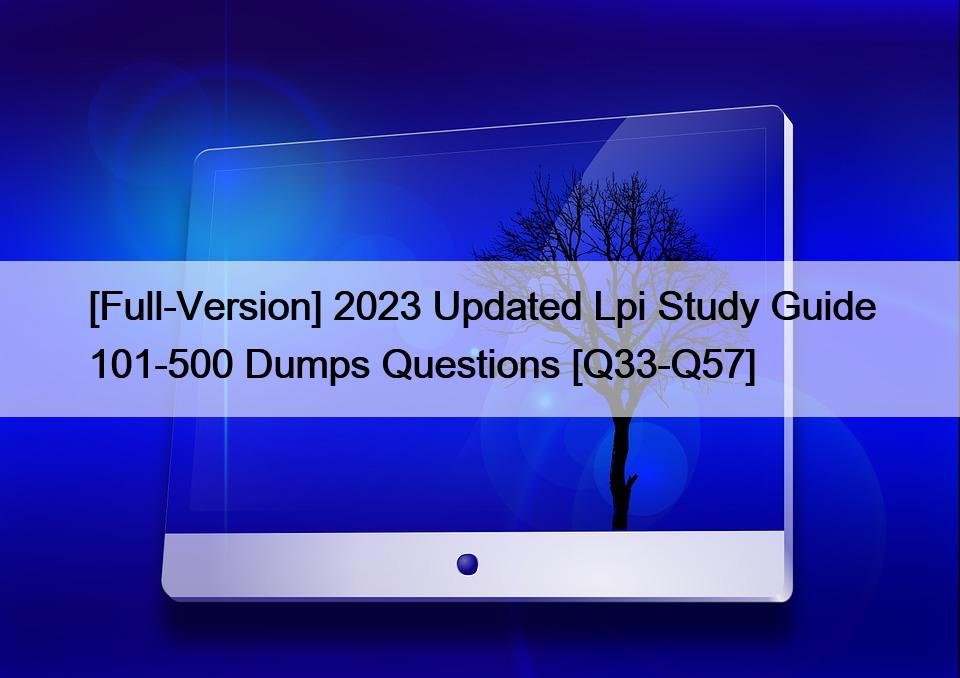[Full-Version] 2023 Updated Lpi Study Guide 101-500 Dumps Questions [Q33-Q57]

[Full-Version] 2023 Updated Lpi Study Guide 101-500 Dumps Questions
Newest 101-500 Exam Dumps Achieve Success in Actual 101-500 Exam
Topics of LPIC-1 Linux Administrator , 101-500 Exam
To know course content so that aspirants can prepare for exam is a must. LPIC-1, 101-500 exam will include following topics :
1. System Architecture
Awareness of acpid. Determine and configure hardware settings Tools and utilities to manipulate USB devices. Alert users before switching runlevels / boot targets or other major system events. Conceptual understanding of sysfs, udev and dbus. Set the default runlevel or boot target. Understanding of SysVinit and systemd. Tools and utilities to list various hardware information (e.g. lsusb, lspci, etc.). Provide common commands to the boot loader and options to the kernel at boot time. Change runlevels / boot targets and shutdown or reboot system Boot the system Awareness of Upstart. Properly terminate processes.
2. Linux Installation and Package Management
Identify shared libraries. Load shared libraries. Awareness of apt. Obtain package information like version, content, dependencies, package integrity and installation status (whether or not the package is installed). Knowledge of basic features of LVM. Install and configure a boot loader such as GRUB Legacy. Ensure the /boot partition conforms to the hardware architecture requirements for booting. Providing alternative boot locations and backup boot options. Interact with the boot loader. Perform basic configuration changes for GRUB 2. Awareness of cloud-init. Linux as a virtualization guest Install, upgrade and uninstall Debian binary packages. Obtain information on RPM packages such as version, status, dependencies, integrity and signatures. Understand Linux extensions which integrate Linux with a virtualization product. Design hard disk layout Determine what files a package provides, as well as find which package a specific file comes from. Awareness of dnf. Understand the general concept of virtual machines and containers.
3. GNU and Unix Commands
Send output to both stdout and a file. Basic file editing Use and modify the shell environment including defining, referencing and exporting environment variables. Know the default priority of a job that is created. Copy, move and remove files and directories individually. Signal a program to continue running after logout. Run jobs in the foreground and background. Change the priority of a running process. Use simple and advanced wildcard specifications in commands. Insert, edit, delete, copy and find text in vi. Understand and use vi modes. Select and sort processes for display. Configure the standard editor. Awareness of Emacs, nano and vim. Modify process execution priorities Send signals to processes. Send text files and output streams through text utility filters to modify the output using standard UNIX commands found in the GNU textutils package. Pipe the output of one command to the input of another command. Use the output of one command as arguments to another command. Remove files and directories recursively. Use regular expression tools to perform searches through a filesystem or file content. Navigate a document using vi. Understand the concepts of special characters, character classes, quantifiers and anchors. Copy multiple files and directories recursively. Use single shell commands and one line command sequences to perform basic tasks on the command line. Using find to locate and act on files based on type, size, or time. Perform basic file management Create, monitor and kill processes Understand the differences between basic and extended regular expressions. Use regular expressions to delete, change and substitute text. Use and edit command history. Use streams, pipes and redirects Monitor active processes. Invoke commands inside and outside the defined path. Usage of tar, cpio and dd.
4. Devices, Linux Filesystems, Filesystem Hierarchy Standard
Know how to change the file creation mask. Verify the integrity of filesystems. Maintain the integrity of filesystems Copying versus linking files. Find files and commands on a Linux system. Use links to support system administration tasks exFAT Use the group field to grant file access to group members. Understand the correct locations of files under the FHS. XFS ext2/ext3/ext4 VFAT Manually mount and unmount filesystems. Configure user mountable removable filesystems. Create partitions and filesystems Manage access permissions on regular and special files as well as directories. Use access modes such as suid, sgid and the sticky bit to maintain security. Repair simple filesystem problems. Configure filesystem mounting on bootup. Monitor free space and inodes. Identify hard and/or soft links. Create links. Use of labels and UUIDs for identifying and mounting file systems.
Updated Lpi 101-500 Dumps – Check Free 101-500 Exam Dumps: https://www.braindumpsit.com/101-500_real-exam.html
|
